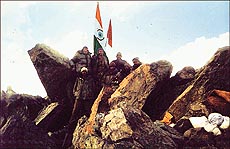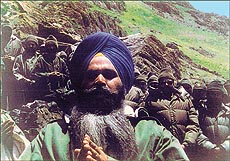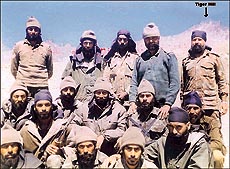Sikh Regiment: Where
valour is a tradition
By Prabhjot
Singh
REMEMBER the Battle of Saragarhi
when Havildar Ishar Singh with 21 Other Ranks (ORs) made
the supreme sacrifice while repulsing an attack by more
than 10,000 Afridi tribesmen in the North West Frontier
Province (NWFP), now in Pakistan? The British Parliament
had then arisen as one man to pay its respect to these
gallant Sikh soldiers. Now, more than 102 years later,
the entire nation has risen again. This time to
acknowledge the triumph of the Sikhs at Helmet and India
Gate ( Tiger Hill features) in the Kargil sector.
 Valour is the second name of the Sikh
Regiment. It has a long and distinguished history. It
continues to be the highest decorated regiment in the
Indian Army with 73 battle honours and 38 theatre
honours. The regiment also enjoys the distinction of
having in its fold the highest decorated "Battalion
of Commonwealth"--- the 1 Sikh --- and the highest
decorated soldier, Naik Nand Singh, who has the Mahavir
Chakra and the Victoria Cross pinned to his chest. Valour is the second name of the Sikh
Regiment. It has a long and distinguished history. It
continues to be the highest decorated regiment in the
Indian Army with 73 battle honours and 38 theatre
honours. The regiment also enjoys the distinction of
having in its fold the highest decorated "Battalion
of Commonwealth"--- the 1 Sikh --- and the highest
decorated soldier, Naik Nand Singh, who has the Mahavir
Chakra and the Victoria Cross pinned to his chest.
Moreover, the regiment
has, in the post-Independence era, won two Param Vir
Chakras, two Ashok Chakras, two Param Vishisht Seva
Medals, 14 Mahavir Chakras, 5 Kirti Chakras, one Uttam
Yudh Seva Medal, 10 Ati Vishisht Seva Medals, 64 Vir
Chakras, 22 Shaurya Chakras, 104 Sena Medals and 31
Vishisht Seva Medals --- a total of 1596 gallantry
awards.
Though the official
history of the regiment dates back to 1846, its
biological heritage has its roots in the teachings and
sacrifices made by the Sikh Gurus. Imbibing the culture
and chivalry of Maharaja Ranjit Singh's erstwhile Khalsa
Army, the ethos and traditions of the regiment got
formalised with the ' Regiment of Ferozepore Sikhs' and
'Regiment of Ludhiana Sikhs' on August 1,1846, through
Capt G. Tebbs and Lieutenant Colonel P. Gordon,
respectively.
And when men and
officers from two of the battalions of this regiment ---
8 Sikh and 14 Sikh -- were inducted into Kargil
operations, they lived up to their rich martial tradition
of self- sacrifice. One had to be in Kargil to understand
the inhospitable terrain where men from Indian infantry
made history. The enemy -- Mujahideens and Pakistan Army
regulars -- had occupied all the ridges or features.
Unlike the picturesque hill stations of Shimla,
Darjeeling, Manali or Chail, the higher reaches, peaks or
features along the Line of Control (LoC) in Kargil, are
not gentle tree and shrub peaks but jagged rocks of
granite and basalt found at this end of the Tibetan
plateau. These are some of the oldest and hardest rocks
in the world.
Devoid of even a blade
of grass, most of these ridges have razor-sharp edges.
The southern rock face is often a sheer cliff. The more
accessible slopes have a 70 degree incline. The ridges
are also narrow and a single machine gun is good enough
to neutralise a 10 to one advantage in manpower at the
ground level. From the positions that the intruders had
occupied, they appeared to be "undefeatable".
 It was
on May 14 that 8 Sikh was assigned the task of
recapturing Tiger Hill. The information given or gathered
was scanty. It was believed that only a few Mujahideens
were holding the feature. As the assault began in the
shape of an initial probing action along the southern
approach, intense fire, both direct and indirect, was
opened by the enemy. Undeterred by the fire, Subedar
Joginder Singh and his platoon continued its march
forward and successfully reached the base of the spur
leading to the Tiger Hill top. It was
on May 14 that 8 Sikh was assigned the task of
recapturing Tiger Hill. The information given or gathered
was scanty. It was believed that only a few Mujahideens
were holding the feature. As the assault began in the
shape of an initial probing action along the southern
approach, intense fire, both direct and indirect, was
opened by the enemy. Undeterred by the fire, Subedar
Joginder Singh and his platoon continued its march
forward and successfully reached the base of the spur
leading to the Tiger Hill top.
Subedar Joginder Singh,
who alongwith Lance Naik Ranjit Singh spearheaded the
retaliatory fire, made the supreme sacrifice. The crucial
foothold gained by the Subedar proved critical in the
ultimate capture of the Tiger Hill.
The quantum of fire of
the enemy proved beyond doubt that it was in strength and
well-fortified at the Tiger Hill. The Hill complex
comprises Tiger Hill (top), Eastern Spur, Western Spur,
India Gate, Rocky Knob and Helmet.
The Army had planned to
isolate Tiger Hill before capturing it. This was achieved
by 8 Sikh by May 21 after dare-devil actions by Sepoys
Rashwinder Singh, Sukhwinder Singh and Jaswinder Singh in
occupying key heights to neutralise enemy fire. In utter
disregard to their personal safety, these gallant men
succeeded in occupying key positions.
Between May 31 and July
2, the men and officers of this battalion continued to
cause heavy damage to the enemy by both direct and
indirect fire and continued their progress forward so as
to close in on the enemy. Each night, they would burrow
through the snow, create a crawl trench and set up a new
post -- moving towards the peak slowly but steadily.
Unmindful of the extremely harsh weather conditions, with
rain, sleet and snow coming upon them along with the
enemy fire everyday, the brave soldiers dared their enemy
to show up and get ready for their final
"kalma". A number of casualties were inflicted.
The assault party lost
Lieutenant Kanad Bhatta-charya in a brave patrolling
encounter. In all, 10 jawans were killed and 48 others
were wounded. These casualties notwithstanding, they
closed on and isolated Tiger Hill from three directions.
It was imperative that the Western Spur was also captured
to bottle up the intruders at Tiger Hill top.
Major Ravinder Singh and
Lieutenant Sehrawat accompanied by four JCOs and 52 ORs
took up the challenging assignment of capturing the
Western Spur. It was on the night of July 4/5 that this
group of gallant soldiers of 8 Sikh left amidst the war
cries of Bole so Nihal to capture Rohino Horn,
Rocky Knob, Helmet and India Gate. These positions had
been heavily fortified and were dominated by the enemy
from Tiger Hill on the east and Trig Heights on the west.
The task was challenging as the approach was from a slope
with a 75 to 80 degree gradient.
 For the marjivre Sikhs, the
extremely bad weather and the steep gradient hardly
mattered. Subedar Nirmal Singh, Naib Subedar Karnail
Singh and Naib Subedar Ravail Singh established a firm
base. Lieutenant RKSehrawat was to coordinate the assault
by three teams. By midnight, all the three teams were
suitably poised for the capture of India Gate, Helmet and
Rocky Knob. As the war cries of Bole So Nihal, Sat
Siri Akal rent the air, the men got going and all
hell broke loose. Intense enemy shelling and direct
firing opened up. A "cock fight" ensued during
which bunkers were cleared one after another. By 4 am,
India Gate and Helmet had been captured. For the marjivre Sikhs, the
extremely bad weather and the steep gradient hardly
mattered. Subedar Nirmal Singh, Naib Subedar Karnail
Singh and Naib Subedar Ravail Singh established a firm
base. Lieutenant RKSehrawat was to coordinate the assault
by three teams. By midnight, all the three teams were
suitably poised for the capture of India Gate, Helmet and
Rocky Knob. As the war cries of Bole So Nihal, Sat
Siri Akal rent the air, the men got going and all
hell broke loose. Intense enemy shelling and direct
firing opened up. A "cock fight" ensued during
which bunkers were cleared one after another. By 4 am,
India Gate and Helmet had been captured.
The attacking troops, in
the meanwhile, had firmed up defences in an area 700
metres by 500 metres. Construction of protective sangars
was immediately taken up. Apprehending a violent
retaliation from the enemy, all preparations for
repulsing any attack were made.
In fact, two major
attacks were repulsed in which Major Iqbal of SSG and
Capt Karnal Sher of 12 NLI were killed along with 30
others. Three JCOs - Sub Nirmal Singh and Karnail Singh
and Naib Subedar Rawail Singh - and 18 ORs made the
supreme sacrifice. The wounded included Major Ravinder
Singh and Lieutenant Sherawat besides 18 ORs. The capture
and defence of the Western Spur facilitated the capture
of Tiger Hill top on July 7. The unit lost a total of 35
men. About 70 werewounded -- a high price. But by sheer
grit , 8 Sikh won the day at Tiger Hill.
After 8 Sikh had
accomplished its task in the high traditions of the
regiment, it was the turn of 14 Sikh, the youngest of the
Sikh battalions, to teach another lesson to the enemy.
On May 27 the battalion
was airlifted to Leh. The advance party led by Major
Rohit Sehgal had already been moved to Channigund to
contain the enemy’s intrusion in Kaksar area. This
party occupied a defensive locality to prevent any
further intrusion into the sensitive Batalik sector and
provide a firm base for offensive operations which were
to follow.
On May 27, the enemy
brought down effective and intense fire on this defensive
location. To neutralise enemy fire, Sepoy Buta Singh, in
an act of exemplary courage and bravery, moved the Medium
Machine Gun to an advantageous postion and brought
effective fire on the enemy for about four hours. The
enemy concentrated its fire to neutralise effective MMG
fire. Sepoy Buta Singh, hit by small arms fire of the
enemy, continued to operate his MMG till he breathed his
last and prevented the enemy from capturing the Company
defended locality.
Immediately on arrival
at Leh, 14 Sikh dispatched a Company column to Chorbatla
to strengthen the lightly held position there. The
Company moved to Hanuthang and on to Handanbrok covering
22 km at an altitude exceeding 15,000 feet. This was a
feat in itself and reflected the physical and mental
robustness of the brave Sikh soldiers.
On June 7, the balance
of 14 Sikh was given the responsibility of Chorbatla. It
moved and occupied the commanding heights along the Line
of Control.
The enemy activity in
the sector was at a somewhat low key. Naib Subedar Jasbir
Singh, in an exemplary effort, established a Section Post
at point 5620 (approx. 19,000 ft). His drive and
enterprise secured the eastern flank of Chorbatla.
Subsequently, the enemy was totally dominated.
|

